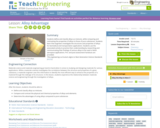
Explore how to determine the amount of compound interest earned on an investment. Assess learning with a quiz. [4:56]
- Subject:
- Mathematics
- Material Type:
- Audio/Video
- Provider:
- Sophia Learning
- Date Added:
- 12/01/2023

Explore how to determine the amount of compound interest earned on an investment. Assess learning with a quiz. [4:56]

Students define and classify alloys as mixtures, while comparing and contrasting the properties of alloys to those of pure substances. Students learn that engineers investigate the structures and properties of alloys for biomedical and transportation applications. Pre- and post-assessment handouts are provided.

Biology 2e is designed to cover the scope and sequence requirements of a typical two-semester biology course for science majors. The text provides comprehensive coverage of foundational research and core biology concepts through an evolutionary lens. Biology includes rich features that engage students in scientific inquiry, highlight careers in the biological sciences, and offer everyday applications. The book also includes various types of practice and homework questions that help students understand—and apply—key concepts. The 2nd edition has been revised to incorporate clearer, more current, and more dynamic explanations, while maintaining the same organization as the first edition. Art and illustrations have been substantially improved, and the textbook features additional assessments and related resources.


By the end of this section, you will be able to do the following:
Define matter and elements
Describe the interrelationship between protons, neutrons, and electrons
Compare the ways in which electrons can be donated or shared between atoms
Explain the ways in which naturally occurring elements combine to create molecules, cells, tissues, organ systems, and organisms

Chem4Kids looks at the 18th element in the periodic table, argon. Content focuses on argon's electrons, where you can find argon in nature and in the home, and how argon combines with other elements.

Here at Chem4Kids.com you can find some great information about the 5th element in the periodic table, "boron." Content focuses on boron's electrons, where you can find boron in nature and in the home, and how boron combines with other elements.

Click on the left navigation terms for some great information about the 6th element in the periodic table, "carbon." Content focuses on carbon's electrons, where you can find carbon in nature and in the home, and how carbon combines with other elements.


Here you can find some great information about the 12th element in the periodic table, "magnesium." Content focuses on magnesium's electrons, where you can find magnesium in nature and in the home, and how magnesium combines with other elements.

Here you can find some great information about the 10th element in the periodic table, "neon." Content focuses on neon's electrons, where you can find neon in nature and in the home, and how neon combines with other elements.

Here you can find some great information about the 7th element in the periodic table, "nitrogen." Content focuses on nitrogen's electrons, where you can find nitrogen in nature and in the home, and how nitrogen combines with other elements.

Here at Chem4Kids you can find some great information about the 11th element in the periodic table, "sodium." Content focuses on sodium's electrons, where you can find sodium in nature and in the home, and how sodium combines with other elements.

Here you can find some great information about the 16th element in the periodic table, "sulfur." Content focuses on sulfur's electrons, where you can find sulfur in nature and in the home, and how sulfur combines with other elements.

Chemical reactions are the foundation of chemistry, and understanding how elements combine and in what ratios helps us to understand the world around us. This pathway provides resources about how different chemicals react, and the ratios in which they react, a field of study known as Stoichiometry (literally: element measuring).

This lesson will introduce the systematic classification of matter used in chemistry, defining the terms heterogeneous, homogeneous, pure substance, mixture, compound, element and providing examples.

Learn how to spot a complex sentence from this Khan Academy video. Many examples are given by Paige and Rosie to help you understand these sentences. Included are questions and answers from the community. [5:06]
Khan Academy learning modules include a Community space where users can ask questions and seek help from community members. Educators should consult with their Technology administrators to determine the use of Khan Academy learning modules in their classroom. Please review materials from external sites before sharing with students.

A video presentation that explains what constitutes a compound-complex sentence and provides examples [7:47]